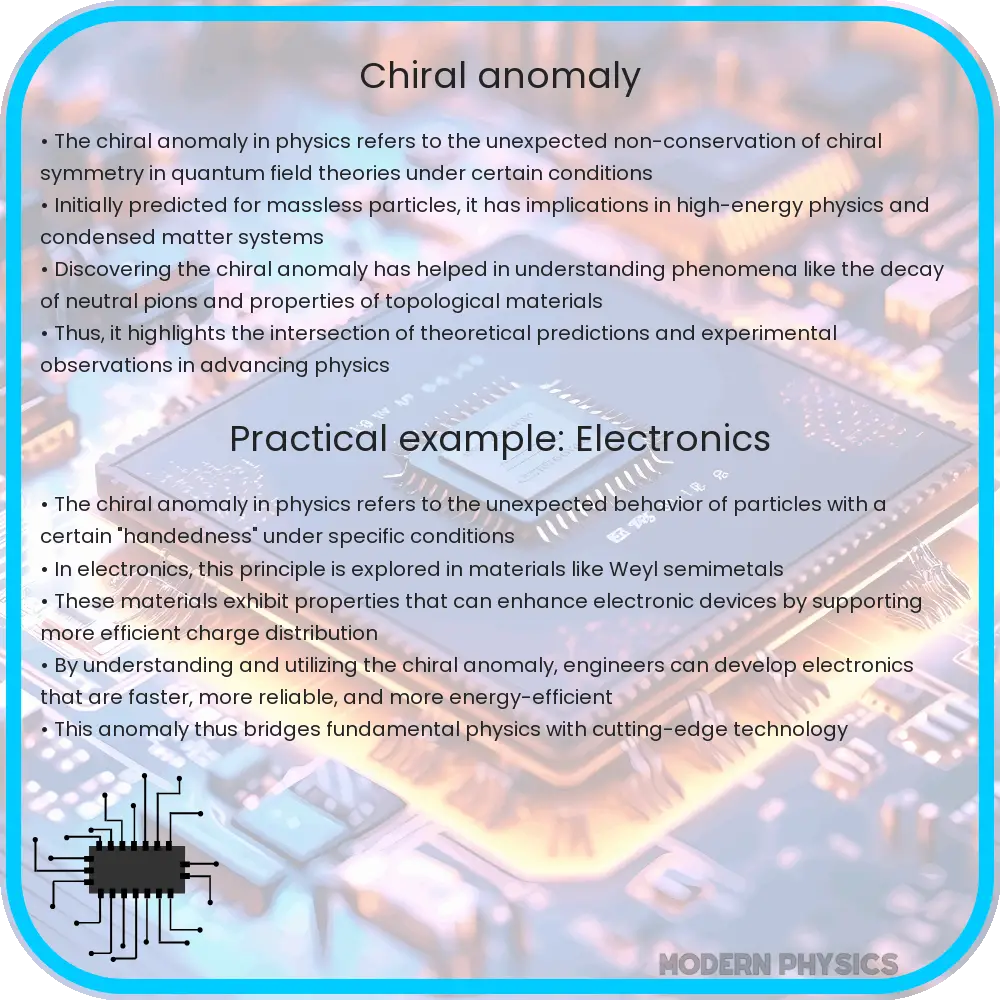Explore the chiral anomaly’s role in quantum physics, its impact on gauge theory, CP violation, and its implications in particle physics and cosmology.

Understanding the Chiral Anomaly in Quantum Physics
The chiral anomaly is a fascinating and complex phenomenon in quantum physics, deeply rooted in the principles of gauge theory and CP violation. It represents a violation of a classical symmetry in a quantum context, specifically within the realm of quantum field theory. This anomaly is pivotal in understanding certain aspects of particle physics, especially in the study of weak interactions and the behavior of quarks and leptons.
Gauge Theory and Its Role in Chiral Anomaly
Gauge theory forms the backbone of our understanding of the fundamental forces in physics. It describes how these forces arise from the symmetry properties of space and time. In the context of the chiral anomaly, gauge theory plays a crucial role. It provides a framework for understanding how certain symmetries, which are expected to hold in classical physics, can be violated at the quantum level. This violation is not arbitrary but occurs in a very specific and predictable way, as described by the mathematics of gauge theory.
CP Violation and Its Connection to the Chiral Anomaly
CP violation is another key element in understanding the chiral anomaly. CP stands for Charge Parity, which involves the symmetry properties of particles and their antiparticles. In certain processes, like the decay of kaons and B-mesons, CP violation occurs, showing that the laws of physics are not the same for particles and antiparticles. This violation is deeply intertwined with the chiral anomaly, as it often occurs in processes where the anomaly is significant.
Chiral Anomaly in Quantum Field Theory
In quantum field theory, the chiral anomaly manifests when certain symmetries of the theory, known as chiral symmetries, are not conserved in the quantum realm. This is particularly evident in the weak interactions, which are responsible for processes like beta decay. The weak force only acts on left-handed particles and right-handed antiparticles, leading to a fundamental asymmetry in nature. This asymmetry is at the heart of the chiral anomaly and is a key factor in understanding CP violation and the matter-antimatter imbalance in the universe.
The study of the chiral anomaly has profound implications for our understanding of the universe. It sheds light on why our universe is composed mostly of matter and not antimatter, and it helps to explain some of the most fundamental aspects of particle interactions. Understanding this anomaly is not just a theoretical pursuit; it has practical implications in the field of particle physics, cosmology, and beyond.
The Practical Implications of Chiral Anomaly
The chiral anomaly is not just a theoretical curiosity; it has significant practical implications in various fields of physics. In particle physics, it provides crucial insights into the behavior of quarks and leptons under the influence of the weak force. This understanding is pivotal in experiments involving high-energy particle accelerators like the Large Hadron Collider (LHC), where precise predictions of particle behavior are essential for discovering new particles and verifying theoretical models.
In the realm of cosmology, the chiral anomaly offers a window into the early universe. It helps in understanding the matter-antimatter asymmetry observed today. According to the Big Bang theory, the universe began with equal amounts of matter and antimatter. However, the observable universe is dominated by matter. The chiral anomaly, through its connection to CP violation, offers an explanation for this imbalance, suggesting that certain processes in the early universe favored the creation and survival of matter over antimatter.
Challenges and Future Prospects
Despite its importance, the chiral anomaly poses significant challenges. One of the primary challenges is the difficulty in creating experimental conditions where the effects of the anomaly can be observed and studied in detail. High-energy particle accelerators have made significant strides in this direction, but there is still much to learn. Theoretical work also continues to evolve, with researchers looking to integrate the chiral anomaly more fully into the standard model of particle physics and beyond.
The future of research in this area is promising. As experimental techniques become more sophisticated and theoretical models more refined, our understanding of the chiral anomaly will deepen. This research has the potential to unlock new aspects of particle physics and cosmology, possibly leading to groundbreaking discoveries about the fundamental nature of our universe.
Conclusion
The chiral anomaly is a fundamental aspect of quantum physics that bridges the gap between abstract theoretical concepts and observable phenomena in the universe. It challenges our understanding of symmetry and conservation laws in the quantum realm and has profound implications in particle physics and cosmology. As research continues, the chiral anomaly stands as a testament to the depth and richness of quantum theory, offering a glimpse into the most fundamental workings of the universe and continuing to inspire awe and curiosity in the scientific community.
